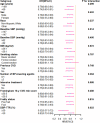Systolic and diastolic blood pressure time in target range and cardiovascular outcomes in patients with hypertension and pre-frailty or frailty status
- PMID: 38552135
- PMCID: PMC11088431
- DOI: 10.1111/jch.14797
Systolic and diastolic blood pressure time in target range and cardiovascular outcomes in patients with hypertension and pre-frailty or frailty status
Abstract
In patients with hypertension and pre-frailty or frailty, the influence of systolic (SBP) and diastolic blood pressure (DBP) time in target range (TTR) on clinical outcomes is unclear. Thus, we conducted a post hoc analysis of the Systolic Blood Pressure Intervention Trial (SPRINT). Classifying 4208 participants into frail and non-frail groups using a frailty index, the study calculated blood pressure time in target range (BP-TTR) for the first three months using the Rosendaal method. The primary endpoint included a composite of nonfatal myocardial infarction (MI), acute coronary syndromes, stroke, acute decompensated heart failure (ADHF), and cardiovascular death. Relationships between BP-TTR and outcomes were analyzed using Kaplan-Meier curves, Cox models, and restricted cubic spline curves, with subgroup analysis for further insights. In a median follow-up of 3.17 years, primary outcomes occurred in 6.7% of participants. Kaplan-Meier analysis showed that a lower systolic blood pressure time in target range (SBP-TTR) (0%-25%) correlated with an increased cumulative incidence of the primary outcome (p < .001), nonfatal MI (P = .021), stroke (P = .004), and cardiovascular death (P = .002). A higher SBP-TTR (75%-<100%) was linked to a reduced risk of these outcomes. The restricted cubic spline (RCS) curve revealed a linear association between SBP-TTR and the primary outcome (non-linear P = .704). Similar patterns were observed for diastolic blood pressure time in target range (DBP-TTR). Subgroup analysis showed that the protective effect of higher SBP-TTR was less pronounced at low DBP-TTR levels (P for interaction = .023). In conclusion, this study highlights the importance of maintaining BP within the target range to mitigate cardiovascular risks in this population.
Keywords: blood pressure; diastolic blood pressure time in target range; frailty; hypertension; systolic blood pressure time in target range.
© 2024 The Authors. The Journal of Clinical Hypertension published by Wiley Periodicals LLC.
Conflict of interest statement
The authors declare that the research was conducted in the absence of any commercial or financial relationships that could be construed as a potential conflict of interest.
Figures





References
-
- Benetos A, Petrovic M, Strandberg T. Hypertension management in older and frail older patients. Circ Res. 2019;124(7):1045‐1060. - PubMed
Publication types
MeSH terms
Substances
LinkOut - more resources
Full Text Sources
Medical
Research Materials
Miscellaneous

